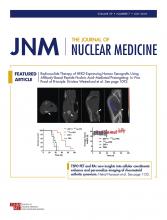TO THE EDITOR: “Where have all the flowers gone, long time passing?” Pete Seeger’s antiwar song became famous when Marlene Dietrich interpreted the German version “Sag mir wo die Blumen sind” in 1962—the same year as Blau et al. introduced skeletal imaging with 18F-labeled sodium fluoride (18F-NaF) (1). It was abandoned in favor of 99mTc-labeled phosphate-based bone tracers that were more readily detectable by the newborn γ-camera, until the reinvention of skeletal 18F-NaF imaging in the present century, thanks to the advent of PET/CT scanners. Seeger’s song ends: “Oh, when will they ever learn?” One is seized by a similar tristesse when reading the recent article by Löfgren et al. (2) comparing planar bone scintigraphy, SPECT/CT, 18F-NaF PET/CT, and 18F-NaF PET/MR for diagnosing bone metastases instead of bone marrow metastases. The consequences are not as serious as war, but serious enough, and this misconception should disappear and not contaminate the thinking of 21st-century cancer management. Nor should misleading results be conveyed to a broader audience as done by AuntMinnie (3), as this may cement the inappropriate use of bone scintigraphy and bone-seeking PET tracers for the detection of skeletal metastases.
Löfgren et al. made a great effort in trying to compare the 4 modalities in what AuntMinnie calls a head-to-head comparison, which it was not, because only 46 of 117 included patients underwent PET/MRI. The study material was heterogeneous, comprising metastases from 2 cancer types (breast and prostate plus 1 renal cancer) without information of therapy. The study was underpowered, with only 16 endpoints (confirmed by biopsy in only 2 cases), and this and multiple equivocal readings hampered analysis to a degree preventing demonstration of significant differences. In addition, the authors calculated positive and negative predictive values and accuracy, disregarding the heavy dependence of these statistics on prevalence, which must be fairly close to equipoise, and not as low as 14%, to make the calculated diagnostic values meaningful (4). The AuntMinnie article states that in the per-patient analysis “PET/CT achieved the greatest accuracy (87%) in correctly identifying true-positive and true-negative cases, followed by SPECT/CT (85%) and planar bone scintigraphy (77%). PET/MRI reached an accuracy of 94% with a smaller sample size of 46 patients.” However, recalculation of numbers given in the table of the AuntMinnie article yields entirely different accuracies, but for reasons stated these numbers have no bearing anyhow.
Unfortunately, both communications disregard the true nature of skeletal metastases, which are located in the bone marrow and not in the osseous bone substance. This was highlighted 10 y ago in a comment by Basu and Alavi (5) to an article clearly demonstrating the superiority of 18F-FDG PET over conventional bone scan (in evaluating skeletal metastasis in patients with nasopharyngeal carcinoma) and described in detail in a succeeding editorial (6). In short, the main message is that skeletal metastasis occurs by seeding in the red bone marrow of circulating tumor cells, retrograde venous flow, or direct extension, and that proliferating cancer cells at some unknown time point give rise to reactive bone formation, which is what can be detected by the 4 modalities compared in the Löfgren study. Opposite to 18F-FDG PET imaging, all 4 modalities bear only indirect evidence of metastatic disease and do so at a much later time point, except perhaps PET/MRI. Similarly destructive to their diagnostic ability is the fact that demonstrated structural bone changes may persist for a long time after active tumor cells have gone due to radiochemotherapy—an unfortunate circumstance that in many cases leads to excessive, long-lasting, and very costly therapy.
Thus, it is imperative to emphasize that the red bone marrow and not osseous bone is the primary location for skeletal cancer spread. Therefore, there is a dire need for modalities that can reliably track and quantify the active skeletal cancer burden and not late-occurring tissue changes. This is exactly what 18F-FDG PET does in most cancers (6,7). However, 18F-FDG PET has limitations. A lower sensitivity of 18F-FDG PET has been reported for sclerotic skeletal metastases particularly in prostate cancer, perhaps because these metastases are relatively acellular or rather because low 18F-FDG uptake of 18F-FDG means low disease activity and clinically less severe cancer. Limitations have led to a call for new and more specific tracers. However, accumulating evidence demonstrates different genetic and phenotypic profiles of primary tumor, regional, and distant metastases (8), indicating that PET imaging of cancer and its metastases with nonspecific 18F-FDG that reflects tumor biology (9) will not become redundant in a foreseeable future. Thus, the chorus “Oh, when will they ever learn?” is still relevant. We recommend that all indirect methods be rejected in favor of comparing 18F-FDG PET with PET studies using more specific tracers for early detection and quantification of bone marrow and not bone metastases.
Footnotes
Published online Sep. 15, 2017.
- © 2018 by the Society of Nuclear Medicine and Molecular Imaging.







